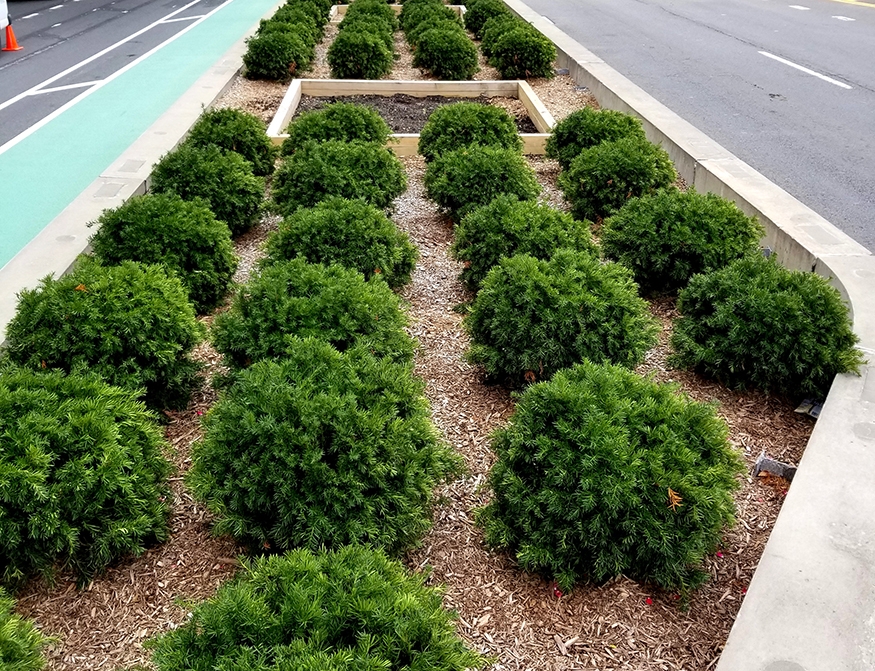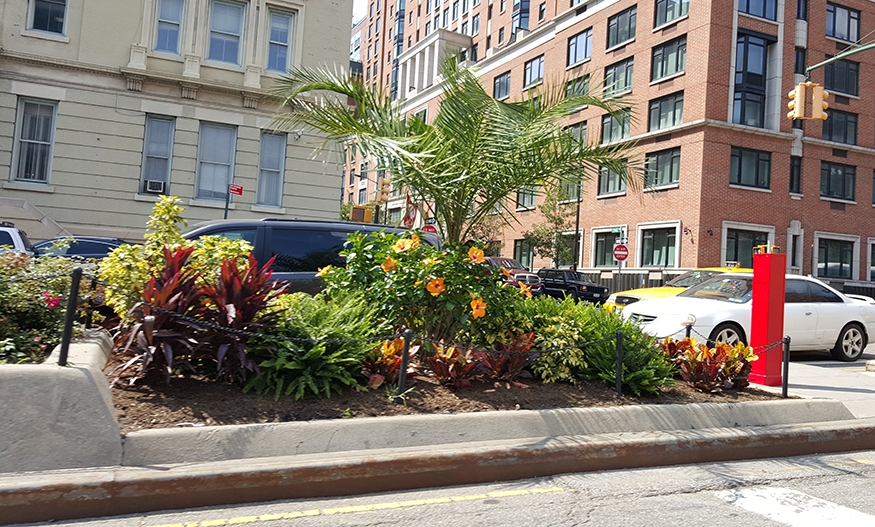A median, typically constructed of concrete or stone, 12 – 24 inches above the roadbed that provides above-ground soil volume for plantings. Generally employed where underground constraints prevent planting at grade and/or along higher-speed roadways.

Grand Concourse, Bronx

Adams Street and Boerum Place, Brooklyn
Benefits
See benefits of Raised Median (Curb Height)
Considerations
See considerations of Raised Median (Curb Height)
- Design the median to the minimum height necessary to accommodate appropriate soil depth
- Consider visibility in relation to the overall height of mature plantings and the raised median (12–24 inches)
- Allow adequate room for trucks and buses to make necessary turns without damaging plant material
- Consider environmental and physical stresses plants must withstand, including drought/inundation, sun/shade, heat/ cold, wind, pollution, road salt, garbage, vehicular damage, and compaction
- Consider the lifespan and longevity of species, as plant replacement will be difficult and costly
- Existing trees at potential raised median sites should be preserved if possible; consider installing the median around the trees to prevent excavation and change of soil grade
- Typically, plantings are watered via a water truck; consider how maintenance workers will access the plantings to perform other regular maintenance activities; this may require a lane closure permit from DOT and should utilize appropriate safety equipment
- Excluding trees, plantings in medians not covered under the Parks/DOT Greenstreets agreement or maintained by DOT require a maintenance agreement
Design
See Raised Median in the Geometry chapter for geometric design guidance; all medians must include a paved area, free of vegetation or obstructions, for pedestrians to safely cross at the intersection
See DOT’s Planted Raised Median Design Guidelines for further information
Where planting trees, see design guidance for Tree Bed
- Planted medians should be a minimum of 7–feet wide to allow for 6 feet of planting space with a 6-inch–wide curb on either side. Exceptions may be approved by DOT and Parks on a case-by-case basis. Where conditions allow, a buffer around the perimeter of the planting bed is preferred for maintenance access
- Planting beds should be sufficiently wide and deep to provide adequate soil volume for plants: 6 feet minimum soil width (wall to wall) and 24 inches minimum soil depth is preferred; exceptions may be approved on a case-by-case basis
- Provide a minimum 24 inches depth of high-quality, well-draining soil; 30 – 36 inches is optimal – see Soils in General Guidelines
- Positive drainage below the planting soil is essential. Any impermeable layers of concrete or asphalt must be removed or appropriately designed weep holes must be included
- Where conditions allow, medians should be planted with large-growing canopy trees
- Tree spacing should be based on the appropriate mature width of the species chosen and must be approved by Parks
- Minimum distance from the curb at the end of the median to the center of the tree trunk is 35 feet
- Where truck and bus traffic is heavy, consider using columnar species to reduce damage to plants
- Consider planting fewer species (excluding trees) to provide continuity and reduce overall maintenance needs; select plants that will provide year-round ornamental interest
- Space shrubs and other plants so as to encourage dense, full growth, and deter weeds, however, do not overcrowd, which can lead to poor air circulation and encourage the spread of pest and disease problems
- Use drought-tolerant, salt-tolerant species that require little to no pruning or deadheading to maintain their shape, size, vitality, and ornamental interest
- In medians with trees, consider understory species that will tolerate varying light conditions as tree species mature and provide more shade
- The roots of plants will be primarily within the top 12 inches of the surface, and are thus more sensitive to freeze-thaw cycles in the winter. Carefully select species which are cold hardy to at least Zone 6A. For added insulation, provide adequate mulch (2 – 3 inches) at the time of planting and replenish as necessary
- For perimeter plantings, choose plants that will not protrude beyond the edge of the raised wall; plants that cascade over the edge of the wall may be acceptable


